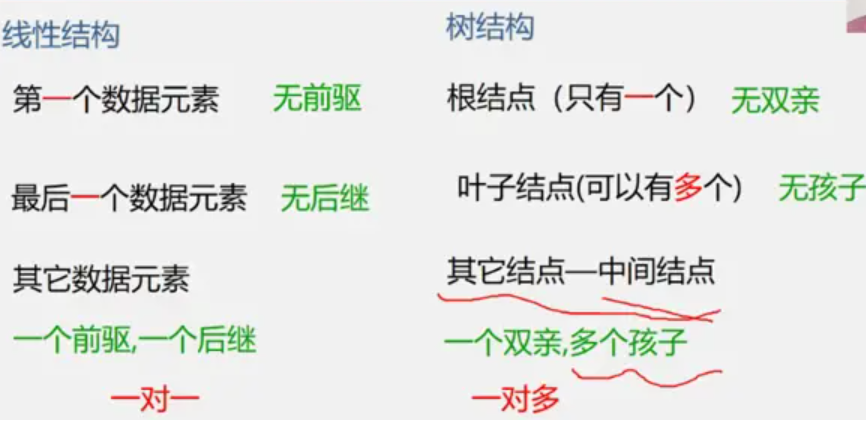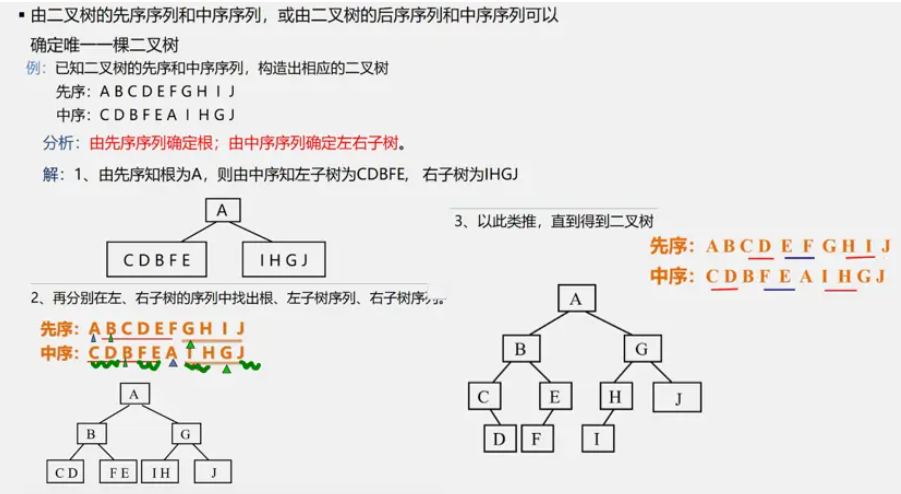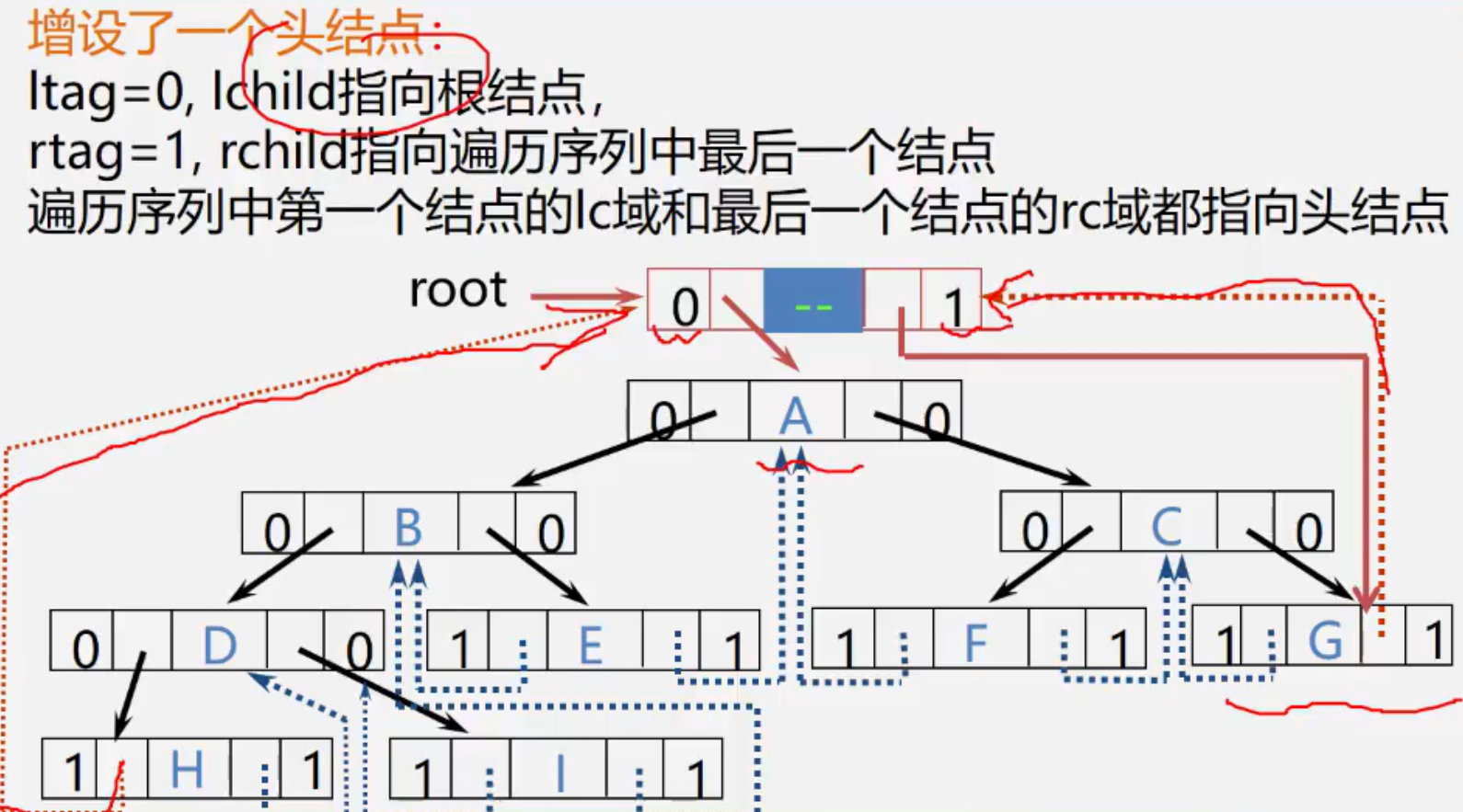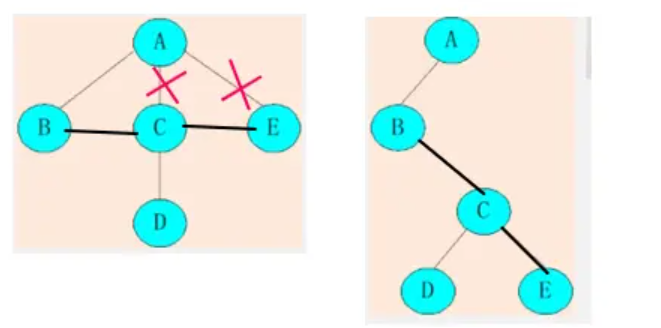树
定义:Tree是n(n>=0)个结点的有限集
若n=0,称为空树
若n>0,则它满足如下两个条件:
- 有且仅有一个特定的称为根(Root)的结点
- 其余结点可以分为m(m>=0)个相互不相交的有限集T1,T2,T3…Tm,其中每一个集合本身又是一棵树,并称为根的子树(SubTree)
树定义是一个嵌套的定义
树的表示形式:

树的相关概念:
结点的度:结点拥有的子树数
树的度:树内各结点的度的最大值
树的深度:树中结点的最大层次(有多少层)
树结构和线性结构的对比

二叉树
注意:二叉树不是树的一种特殊情况。

二叉树定义:由空集或由一个根结点以及两棵互不相交的左右子树组成。
特点:
- 每个结点最多有两个孩子
- 子树有左右之分,次序不能颠倒
- 二叉树可以是空集合,根可以有空的左子树或空的右子树。
二叉树的性质



两种特殊的二叉树





二叉树的存储结构
顺序存储
按照满二叉树的结点层次编号,依次存放二叉树中的数据元素。


二叉树的链式存储结构



二叉树的遍历
定义:是指从根结点出发,按照某种次序依次访问二叉树中所有结点,使得每个结点被访问一次且仅被访问一次
二叉树的遍历方式(左-右)
二叉树的遍历方式有很多,如果我们限制了从左到右的习惯方式,那么主要就分为四种。
1. 先序遍历
先要判断是否为空树,如果是,则直接返回空操作。
否则进行如下操作:
先访问根结点
然后遍历左子树
最后遍历右子树
(根-左-右)

2. 中序遍历
先要判断是否为空树,如果是,则直接返回空操作。
否则进行如下操作:
从根结点开始(注意并不是先访问根节点)
先遍历根结点的左子树
然后再访问根结点
最后遍历右子树
(左-根-右)

3. 后序遍历
先要判断是否为空树,如果是,则直接返回空操作。
否则进行如下操作:
先左,后右,最后根

4. 层次遍历
先要判断是否为空树,如果是,则直接返回空操作。
否则进行如下操作:
从树的第一层,即根结点开始访问
按照从上到下逐层遍历
同一层中则按照从左到右逐个访问结点
构造二叉树
知道先序序列和中序序列可以构造二叉树,如图所示。

知道后序序列和中序序列,可以构造二叉树,如图所示。

二叉树的算法实现
构造一棵二叉树
class TreeNode {
int val;
TreeNode left;
TreeNode right;
TreeNode() {}
TreeNode(int val) { this.val = val; }
TreeNode(int val, TreeNode left, TreeNode right) {
this.val = val;
this.left = left;
this.right = right;
}
}
先序遍历
递归算法实现
public class Solution {
public List<Integer> preorderTraversal(TreeNode root) {
List<Integer> res = new ArrayList<>();
preorder(root, res);
return res;
}
//递归算法
public void preorder(TreeNode root, List<Integer> res) {
if (root == null) {
return;
}
res.add(root.val);
preorder(root.left, res);
preorder(root.right, res);
}
}
迭代算法实现
public class Solution2 {
public List<Integer> preorderTraversal(TreeNode root) {
List<Integer> res = new ArrayList<>(); //存放结果
Stack<TreeNode> stack = new Stack<>(); //存放节点
while (root != null || !stack.isEmpty()) {
while (root != null) {
res.add(root.val);
stack.add(root);
root = root.left;
}
root = stack.pop().right;
}
return res;
}
}
中序遍历
递归算法实现
public class Solution {
public List<Integer> inorderTraversal(TreeNode root) {
List<Integer> list = new ArrayList<>();
inorder(root, list);
return list;
}
public void inorder(TreeNode root, List<Integer> list) {
if (root == null) {
return;
}
inorder(root.left, list);
list.add(root.val);
inorder(root.right, list);
}
}
迭代算法实现
public class Solution2 {
public List<Integer> inorderTraversal(TreeNode root) {
List<Integer> list = new ArrayList<>();
//创建一个栈
Stack<TreeNode> stack = new Stack<>();
//当前指向的节点root和栈都为空时,才结束遍历
while (root != null || !stack.isEmpty()) {
//当当前节点为空时,出栈,否则入栈
while (root != null) { //把左边子树都遍历完成,把左子树中的每个根节点入栈保护起来
stack.push(root);
root = root.left;
}
root = stack.pop();
//出栈的节点的值就是当前要访问的值
list.add(root.val);
root = root.right;
}
return list;
}
}
后序遍历
递归算法实现
class Solution {
public List<Integer> postorderTraversal(TreeNode root) {
List<Integer> res = new ArrayList<>();
postorder(root, res);
return res;
}
//递归法
public void postorder(TreeNode root, List<Integer> res) {
if (root == null) {
return;
}
postorder(root.left, res);
postorder(root.right, res);
res.add(root.val);
}
}
迭代算法实现
class Solution2 {
public List<Integer> postorderTraversal(TreeNode root) {
List<Integer> res = new ArrayList<>(); //存放结果集
Stack<TreeNode> stack = new Stack<>(); //暂存节点
while (root != null || !stack.isEmpty()) {
while (root != null) {
//先按照根右左顺序遍历,然后进行反转,就变成左右根顺序了
res.add(root.val); //把当前指向的节点的值放到集合中
stack.push(root); //把右子节点都入栈,先入栈的后弹出
root = root.right; //改变指向
}
//经过上面的while循环,root已经指向树的最右边的叶子节点
TreeNode cur = stack.pop(); //出栈叶子节点的双亲节点
root = cur.left; //双亲节点的左子节点
}
//因为是根据 根-右-左 顺序来遍历的,所以需要反转结果集
Collections.reverse(res);
return res;
}
}
层次遍历
public class Solution {
public List<List<Integer>> levelOrder(TreeNode root) {
List<List<Integer>> res = new ArrayList<>();
if (root == null) {
return res;
}
LinkedList<TreeNode> queue = new LinkedList<>();
queue.add(root); //添加根节点
while (!queue.isEmpty()) {
List<Integer> list = new ArrayList<>();
int curLevelNum = queue.size(); //当前层的节点个数
for (int i = 0; i < curLevelNum ; i++) { //遍历当前层
TreeNode curNode = queue.removeFirst(); //移除队首节点
list.add(curNode.val); //把队首节点的值添加到临时集合list中
if (curNode.left != null) { //移除队首节点时,同时把左右节点都入队
queue.add(curNode.left);
}
if (curNode.right != null) {
queue.add(curNode.right);
}
}
res.add(list);
}
return res;
}
}
输出的结果

如果要输出[1, 2, 3, 4, 5]的形式,需要把for循环去掉
扩展
N叉树的层次遍历
public class Node {
public int val;
public List<Node> children;
public Node() {}
public Node(int _val) {
val = _val;
}
public Node(int _val, List<Node> _children) {
val = _val;
children = _children;
}
}
public class Solution {
public List<List<Integer>> levelOrder(Node root) {
List<List<Integer>> res = new ArrayList<>();
if (root == null) {
return new ArrayList<>();
}
Queue<Node> queue = new LinkedList<>(); //定义一个双端队列
queue.offer(root);
while (!queue.isEmpty()) {
List<Integer> temp = new ArrayList<>(); //保存每层中节点的值
int size = queue.size();
for (int i = 0; i < size; i++) {
Node node = queue.poll();
temp.add(node.val);
for (int j = 0; j < node.children.size(); j++) {
if (node.children.get(j) != null) {
queue.offer(node.children.get(j));
}
}
}
res.add(temp);
}
return res;
}
}
二叉树的锯齿形层序遍历
public class Solution {
public List<List<Integer>> zigzagLevelOrder(TreeNode root) {
List<List<Integer>> res = new ArrayList<>();
if (root == null) {
return new ArrayList<>();
}
Queue<TreeNode> queue = new LinkedList<>();
queue.add(root);
int index = 1; //层次
while (!queue.isEmpty()) {
List<Integer> temp = new ArrayList<>();
int size = queue.size();
for (int i = 0; i < size; i++) { //遍历当前层中的节点
//为什么不用remove方法,因为当队列为空时,remove方法会报异常,poll方法会返回null
TreeNode node = queue.poll();
temp.add(node.val); //把当前节点值保存起来
//如果左节点不为空,则放到队列中,充当下次遍历的节点
if (node.left != null) {
//为什么不用add方法,因为当队列满时,add方法会报异常,offer方法会返回false
queue.offer(node.left);
}
//如果右节点不为空,则放到队列中,充当下次遍历的节点
if (node.right != null) {
queue.offer(node.right);
}
}
//判读是单数层还是双数层,单数层遍历方向为从左到右顺序
if ((index & 1) == 1) {
res.add(temp);
} else {
Collections.reverse(temp); //双数层时,需要反转
res.add(temp);
}
index++;
}
return res;
}
}
Huffman树
定义
给定n个权值作为n个叶子结点
构造一棵二叉树,如果树的带权路径长度达到最小,则这棵树被称作哈夫曼树。
权(weight): 将树中结点赋给一个有着某种含义的数值,(具体的意义根据树使用的场合确定)则这个数值称为该结点的权。
结点的带权路径长度:从根结点到该结点之间的路径长度与结点上权的乘积。
树的带权路径长度:从树根到每一个结点的路径长度之和

构造哈夫曼树的算法
-
构造森林全是根

-
选用两小造新树

-
删除两小添新人

-
重复2,3剩单根
总结
包含n棵树的森林要经过n-1次合并才能形成哈夫曼树,共产生n-1个新结点
所以哈夫曼树的总的结点数是n+n-1=2n-1个结点。
哈夫曼树的结点度为0或度为2,没有度为1的结点。
权值越大离根越近,权值越小离根越远。
Huffman编码


线索二叉树







树与森林
树一定是森林,但森林不一定是树

树的表示方法
双亲表示法
定义结构数组存放树的结点,每个结点含两个域。
数据域:存放结点本身信息。
双亲域:指示本结点的双亲结点在数组中的位置。
特点:找双亲容易,找孩子难。

孩子链表

带双亲的孩子链表

孩子兄弟表示法


树与二叉树的转换
树转二叉树



二叉树转树

森林与二叉树的转换
森林转二叉树


二叉树转森林


树与森林的遍历
树的遍历
有三种遍历方式:
- 先根遍历:若树非空,则先访问根结点,然后依次先遍历各棵子树。
- 后根遍历:若树非空,则先依次后根遍历各棵子树,然后访问根结点。
- 层次遍历:若树非空,则自上向下自左向右访问树中的每个结点。

森林的遍历


Q.E.D.










